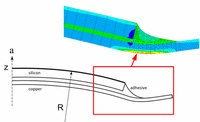By means of X-ray diffraction, qualitative and quantitative phase analysis (e.g. retained austenite quantification) as well as determination of textures (preferred orientation) and residual stresses are routinely performed at MCL.
The recently developed Rocking-Curve method allows for the determination of the curvature of monocrystalline surfaces and additionally enables the calculation of the residual stresses if the mechanical properties are known. Amongst others, the method is relevant for microelectronic components (e.g. silicon wafers) embedded in translucent organic resins which are subjected to cyclic thermal loading.
For an appropriate measurement, the angle between incident X-ray beam and detector is set to a specific diffraction peak of the investigated single crystal. The diffraction intensity is recorded as a function of the sample orientation, with the rotation axis perpendicular to incident and diffracted beam. If the surface is curved, all surface zones with a specific orientation contribute to diffraction. Repeated measurements enable the reconstruction of the shape of the surface.



















![[Translate to Englisch:] XRD Goniometer (Bruker D8 Discover) für Rocking-Curve Verfahren](/fileadmin/_processed_/0/c/csm_Kruemmungsanalyse_Bild_XRD2_3dc5ba03b4.jpg)
